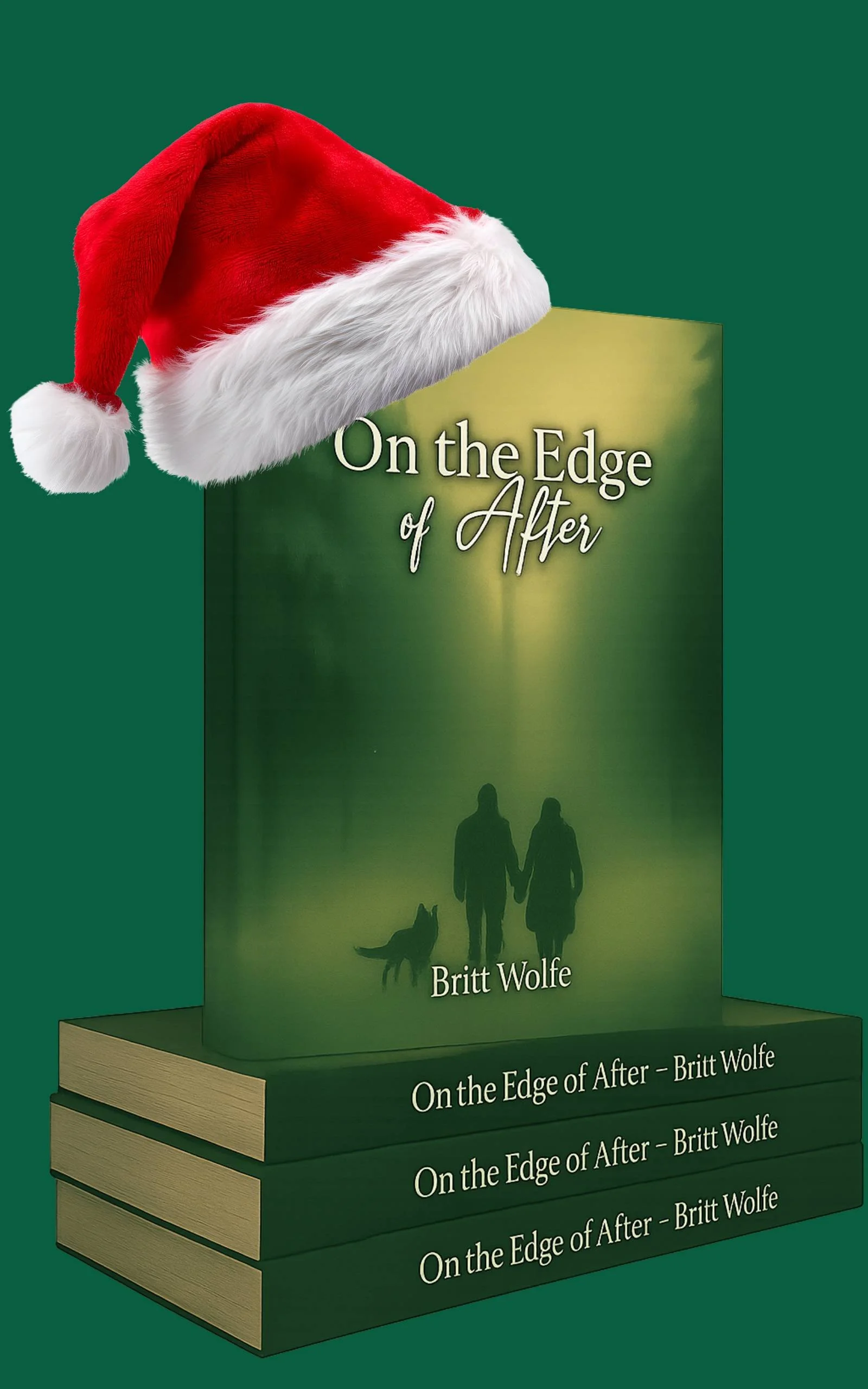📲 Instant download. Works on phones, tablets, Kindle apps, and e-readers.
THIS HOLIDAY SEASON, FIND A LOVE STORY THAT STAYS WITH YOU.
On the Edge of After by Britt Wolfe
A Heart Still Healing. A Love Worth Risking.
On the Edge of After is a slow-burning, emotionally rich love story about grief, hope, and the quiet courage it takes to begin again — especially at a time of year when love feels both closer and farther than ever.
Widowed divorce lawyer Merritt Clarke isn’t looking for love — not anymore. But when she crosses paths with Beau Laurent, a rising politician weighed down by his own ghosts, everything shifts. Their connection is electric. Their timing? Impossibly wrong. But some stories refuse to wait.
If you’re craving a beautiful, healing read to curl up with this Christmas, you’ve just found it.
For Readers Who Love:
Grief-to-healing journeys that don’t flinch
Quiet moments that ache with meaning
Fierce, flawed, unforgettable characters
Stories that linger long after the final page
If you’ve ever held your breath through heartbreak — especially during the holidays — this is the story you’ve been waiting for.
Start Reading today!
Curl up with something beautiful. Click here to order your digital copy — holiday pricing ends soon.
Looking for a meaningful Christmas gift? There’s nothing more powerful than a story that heals.
Meet the People of Norland:
At the heart of On the Edge of After is Merritt Clarke — a woman with a story that begins where everything else seems to end. Quiet strength, unexpected turns, and a journey she never saw coming.
Click here to meet Merritt.
In Norland’s complex political landscape, Beau Laurent stands at the quiet intersection of power and personal loss. A man shaped by both public responsibility and private heartbreak — but his story, like Norland itself, holds far more beneath the surface.
Click here to meet Beau.
In a world of complicated people and tangled emotions, Sophie is pure joy on four paws. Loyal, loving, and always nearby, she follows Merritt through every chapter — tail wagging, heart full, and ready for whatever comes next.
Click here to meet Sophie.
In the shadows of Norland’s polished institutions, André Buchner moves unnoticed—watching, remembering, calculating. A man shaped by abandonment, addiction, and a lifetime of near-invisibility. But like Norland itself, what lurks beneath the surface is far more dangerous than it first appears.
Click here to meet André.
Everett Cole never needed the spotlight to leave an impact. Steady, loving, and fiercely loyal, he built his life around the woman he loved and the quiet joy of the mountains that called him home. His absence left a hole — but his presence is everywhere.
Click here to meet Everett.
Delphine Moreau has built a life most would envy — carefully curated, meticulously staged, and always just out of reach. But beneath the glamour lies a quieter desperation: the fear of being left behind. For Delphine, love, power, and survival have always been impossible to separate.
Click here to meet Delphine.
At the heart of the Laurent family are three very different, deeply connected siblings — each carrying their own quiet strength, and each navigating a world far more complicated than most their age. Bound by love, shaped by loss, and growing into the legacy they never asked for.
Click here to meet the Laurent children.
Beneath Sylvie Nakamura’s calm precision lies a quiet, unshakeable loyalty. Tactical, disciplined, and fiercely protective, she reads every threat — and every heart — long before anyone else. The rules may guide her, but the people she protects will always come first.
Click here to meet Sylvie.
When the stakes rise, Quinn McAalister is the one they call. Tactical, unflinching, and impossible to ignore, she reads threats before they ever materialize — and eliminates them before anyone else even sees the risk.
Click here to meet Quinn.
Avery Sinclair has always known how to light up a room. Effortlessly charming, fiercely loyal, and impossible to forget, she carries both the weight of her family name and the rare ability to make anyone feel seen — even when she keeps her own heart carefully guarded.
Click here to meet Avery.
For Sebastian DuPont, power isn’t an accident — it’s a design. Ruthless, brilliant, and endlessly calculating, his empire stretches far beyond Norland’s borders. Every move is deliberate. Every alliance, carefully constructed. And his story is far from finished.
Click here to meet Sebastian.
Power doesn’t always wear a title. For Genevieve DuPont, influence is woven into every alliance, every rumour, and every perfectly curated appearance. As the matriarch of one of Norland’s most powerful families, her reach extends far beyond what anyone sees.
Click here to meet Genevieve.
Quiet strength often hides the heaviest stories. Naya Swiftwater has carried more than most — through heartbreak, loss, and the kind of past she rarely speaks of. But in every piece she creates, and in every step forward, her resilience continues to shape the family — and the world — around her.
Click here to meet Naya.
At the centre of Norland’s shifting political landscape stands Greyson Hartwell — steady, measured, and impossible to read. A master of quiet negotiation and carefully controlled power, his story is one of balance, ambition, and the cost of holding it all together.
Click here to meet Greyson.
At the intersection of politics and public perception stands Eleanor Hartwell — poised, brilliant, and rarely off balance. As Norland’s First Lady and one of its most skilled strategists, her influence is felt long before her name is ever mentioned.
Click here to meet Eleanor.
For Victor Hargrave, power isn’t something you earn — it’s something you take, and something you hold. Calculated, commanding, and never far from the centre of Norland’s sharpest divides, his story is written in strategy and ambition.
Click here to meet Victor.
In a country divided by power and ambition, Imogen Rainer stands for something quieter — and perhaps harder: the future. A voice of steady conviction in uncertain times, her story is rooted in both the land she came from and the world she hopes to leave behind.
Click here to meet Imogen.
In Montclair, few names carry more weight — or spark more debate — than Jacques Desrosiers. A man driven by identity, ambition, and the future of his province, his story is as complicated as the country he’s determined to reshape.
Click here to meet Jacques.
In a country where every headline is carefully crafted, Lissa Tremblay has made a career of cutting through the noise. Unflinching, insightful, and never far from the heart of Norland’s political storm — the story always finds her.
Click here to meet Lissa.



















